Coined the ‘Great American Eclipse’ by the American media, a total solar eclipse on Monday 8th April will make a 115-mile-wide path across North America between the Pacific coast in NW Mexico and New Foundland in the Canadian Atlantic.
The eclipse will begin at sunrise over the Pacific Ocean, cutting through Mexico’s Pacific Coast at about 11:07 a.m. PT (8:07 a.m. ET). It will then enter the U.S in Texas and travel through Oklahoma, Arkansas, Missouri, Illinois, Kentucky, Indiana, Ohio, Pennsylvania, New York, Vermont, New Hampshire, and Maine. Small parts of Tennessee and Michigan will also experience the total solar eclipse.
The duration of totality will be up to 4 minutes and 27 seconds, almost double that of The Great American Eclipse of August 21, 2017. The 2017 total solar eclipse was witnessed by about 20 million people from Oregon to South Carolina, and the upcoming 2024 Great American Eclipse is likely to be witnessed by millions more.
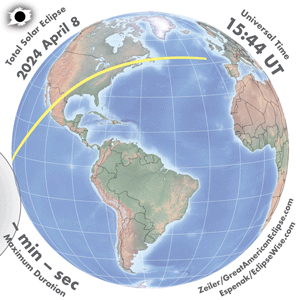
Image coutesy of greatamericaneclipse.com
Weather Holidays, part of Netweather, are running a sold-out 14-day tour with a day watching the Eclipse, a few days beforehand travelling and positioning, then the rest of the time devoted to chasing severe storms somewhere over the Plains of central USA.
Tour Leader, Paul Botten, says: “Having chased and witnessed the August 2017 Eclipse in Wyoming we at Weather Holidays are attempting the 2024 April 8th Eclipse as well. Being early Spring has its challenges over late summer with an active Jet Pattern over the United States no doubt complicating matters along with logistics of a much bigger population over the Eclipse Path. We have initially chosen Arkansas as a starting point away from Texas as this gives us more wriggle room for moving about on Eclipse Day trying to find clear skies.”
The total eclipse will take place on Monday, so we are close enough now to start looking at where may see clear skies and where could be cloudy, though in reality it’s difficult to accurately predict cloud cover for a given area until the day, so it will be ‘nowcasting’ to get the ideal position if there is any amount of cloud is forecast for an area. There can be meteorological set-ups, e.g. under anticyclones, which can increase greatly the chances of clear skies over large areas in spring. But even with low pressure and a stormy pattern, there can be clear skies, particularly in the morning and early afternoon before storms typically develop from mid-late afternoon from the heat building through the day.
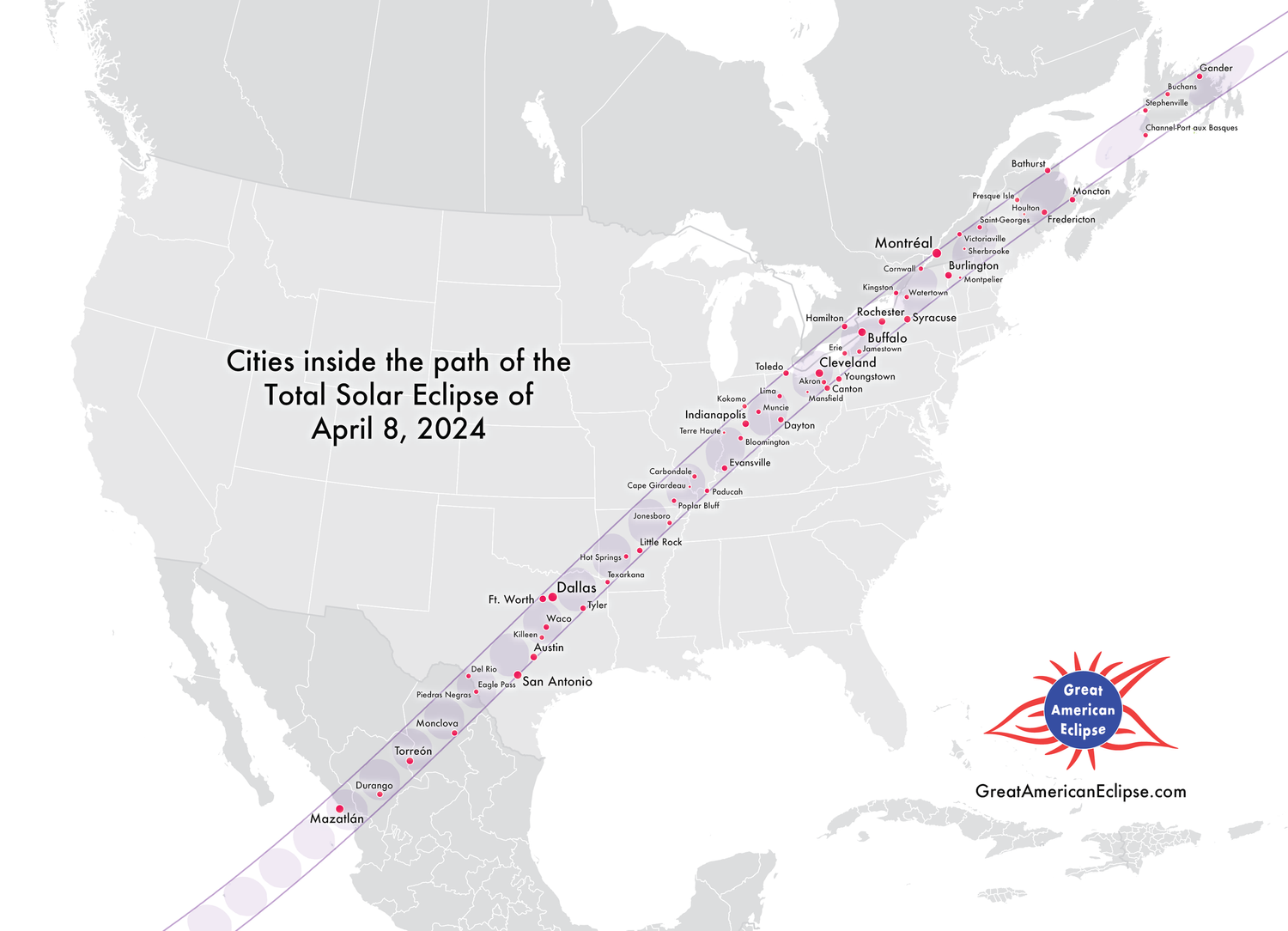
A total eclipse is when the moon completely covers the sun’s face. The timings that totality starts in all 13 states where the total solar eclipse will be visible on April 8 are in the table below:
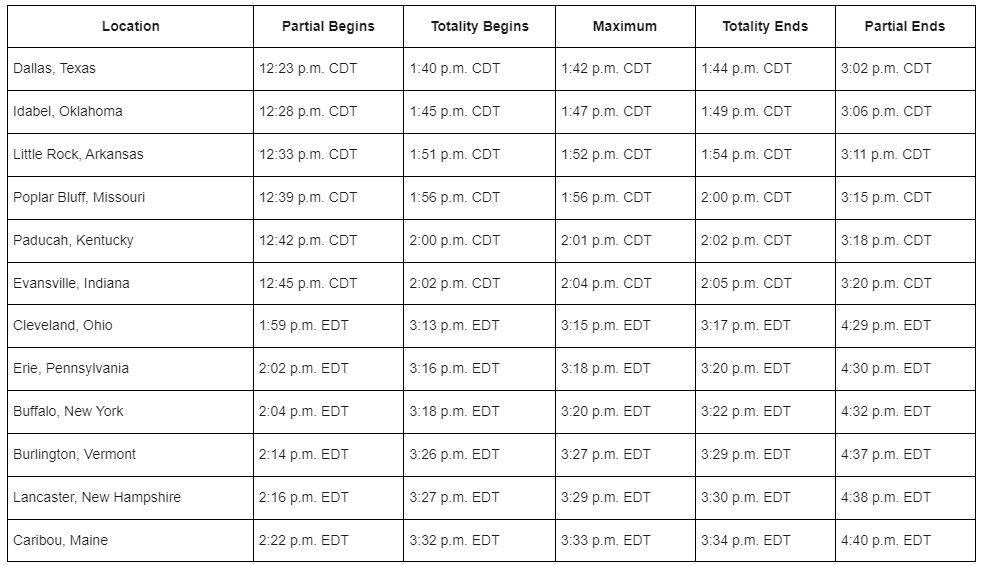
For the WeatherHolidays team, whose overnight stay the night before will be in Arkansas, totality will begin in the early afternoon. Dallas in Texas the totality starts at 1.40pm, Little Rock in Arkansas it starts 1.51pm, Poplar Bluff in Missouri further northeast it starts 1.56pm. If the group need to travel further northeast towards the Ohio Valley that morning to reach clearer skies, then Paducah in Kentucky (where the Ohio and Mississippi rivers meet) – totality starts at 2pm.
Challenges of getting in position for the 2024 total eclipse in the USA
The most obvious challenge is getting to somewhere which will have clear skies. The Weather Holidays team booked hotel rooms for the night before the eclipse over a year ago, virtually the day they became available, as the demand through the path of totality is so high. Although guests arrive at Dallas Fort Worth airport in Texas to be picked up for the tour, they will travel to a hotel in the Ozark Mountains in northern central Arkansas, but under the path of totality, for the night before the eclipse. The area of the hotel is much less populated than much of Texas where the totality path crosses. Also, the hotel is ideally placed, should it be forecast to be cloudy in the area of the hotel, to drive further northeast along totality path into and across Missouri and states further northeast into the Ohio Valley, if need be, to find clearer skies. Though it may mean an early start to get into position should this be the case.
Looking at weather models forecasts and the 12z ECMWF and GFS suggest it may be cloudy along the path of totality in Texas, Arkansas, southern Missouri and further northeast through parts of the states taking in the Ohio Valley. A cold front moving east from the High Plains across southern states the previous day could become a trailing cold front that’s slow-moving near the path on Monday – bringing cloudy skies and perhaps some rain, or even storms later in the day. However, the front may clear through quicker than models suggest. Cloud breaks may develop to the north of the front too which will still be in range of the totality path.
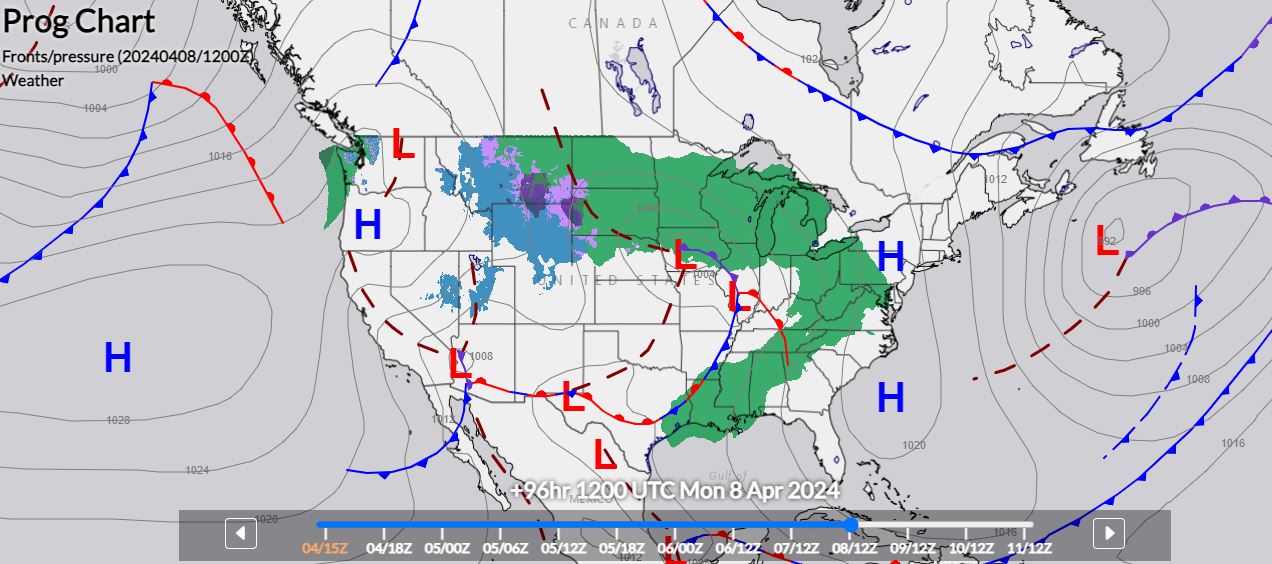
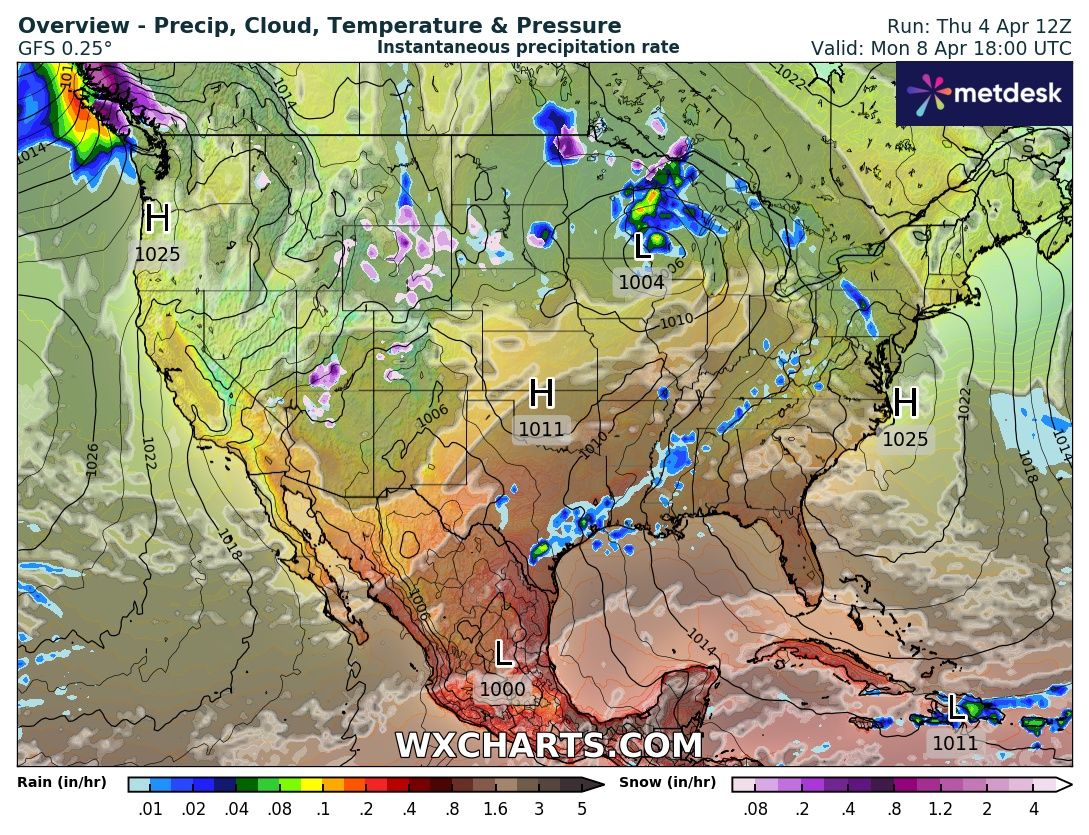
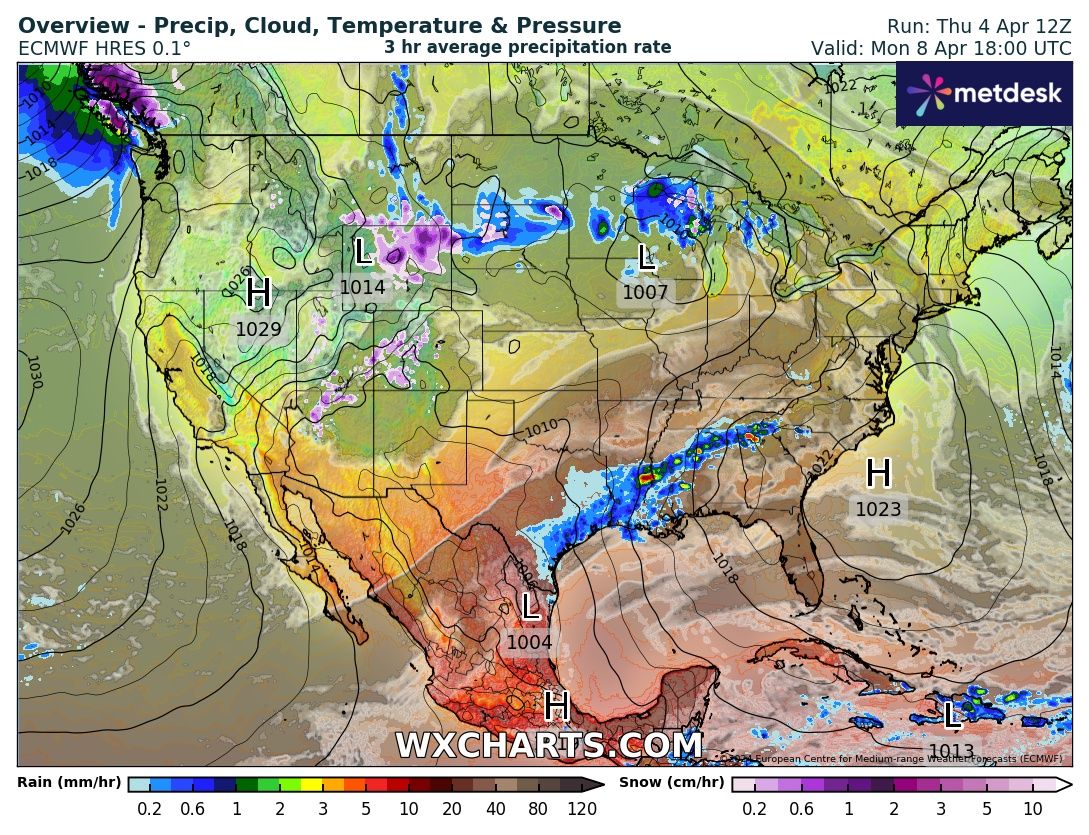
Other challenges will be the amount of extra vehicles on the roads with millions of other people travelling and then jostling to find spots to view the eclipse outdoors. If the areas for clear skies in the totality path become small then this may make it even busier on some roads. It could slow down travel and cause some traffic issues.
At least five million travelled for 2017 eclipse, but even more are expected to gather to witness this year’s total eclipse in the USA. Already an estimated 31 million live in the path of totality, this compares with 12 million in 2017. The Federal Highway Administration (FHWA) are predicting 5 million people will be travelling to the path of totality between Texas and Maine and are advising those travelling to the path to extend stays either side of the 8th to avoid traffic the day before. The totality path will be a 3-hour drive away from 8 major cities with a population greater than 2 million, including Chicago, Houston, and Toronto. By contrast, the 2017 eclipse path of totality was a 3-hour drive away from only three larger metropolitan areas: St. Louis, Kansas City, and Portland, Oregon.
The American Red Cross suggests ‘Five Things You Should Do If Traveling to See the Eclipse:’
- Pack an emergency kit in case you get stuck in traffic or can’t find a place to stay. Include water, non-perishable food, a flashlight, battery-powered radio, first aid kit, medications, supplies for an infant if applicable, a multi-purpose tool, personal hygiene items including toilet paper, cell phone chargers, extra cash, blankets, maps of the area and emergency contact information. Make a plan for where you’ll stay overnight, if needed
- Check the weather forecast ahead of time and plan accordingly
- Keep your gas tank full so you don’t run out while stuck in traffic.
- Let someone know where you are going and the route you plan to take to get there.
- Pick an easy to remember meeting location if someone gets separated from your group.
Photographing the eclipse
Photographing an eclipse of the Sun is fun and easy. However, you will need to use a special Solar Filter to protect your eyes and your camera. DO NOT look at the sun with your naked eyes. Permanent damage to your eyesight, and even blindness, may result. If you do want to look directly at the sun, wear certified solar viewing glasses when viewing the sun before, during, and after an eclipse. Prolonged exposure causes permanent damage. During an eclipse, when the moon covers a portion of the sun, the intensity of the light remains constant. The only time it is safe to look toward the sun with the naked eye is during the brief period of totality at the height of a total eclipse of the sun.
A solar eclipse occurs whenever the Moon’s shadow falls on the Earth. This can only happen during New Moon when the Moon passes between the Sun and Earth. Although there is a New Moon every 29 1/2 days, there are usually only 2 or 3 solar eclipses each year. That’s because the Moon’s orbit is tipped 5 degrees to Earth’s so the Moon’s shadow misses Earth during most New Moons.
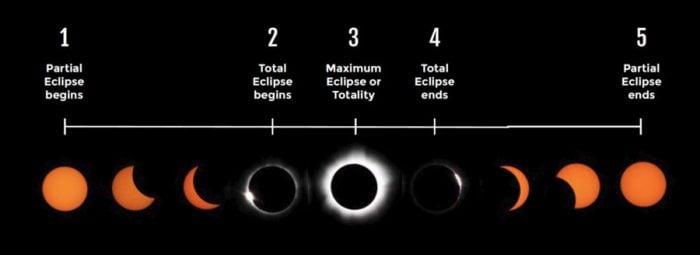
For a total eclipse, the last remaining minutes of the partial phases can be quite dramatic and beautiful. The crescent of the Sun grows thinner as the Moon’s shadow approaches. The abrupt darkness of totallity is stunning and quite unlike you’ve ever seen. And the incredible solar corona is simply the most awe-inspiring naked-eye sight in all of nature. Certainly the most remarkable sight
Lots to consider for those travelling to see the total eclipse. But best of luck for the Weather Holidays group which will be out there. Some amazing photographers on the tour, so we’ll hopefully be able to share some of the photos next week after the event.

Dr. Thomas Hughes is a UK-based scientist and science communicator who makes complex topics accessible to readers. His articles explore breakthroughs in various scientific disciplines, from space exploration to cutting-edge research.








